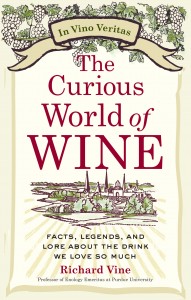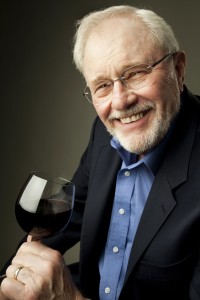Dr. Richard Vine’s “The Curious World of Wine”
The trend in movies and novels recently asserts that quantity equals quality. In an environment of 500 page novels and two-and-one-half-hour movies, Dr. Richard Vine’s new book, “The Curious World of Wine” is refreshing. Dr. Vine, a former enology professor at Purdue University, covers the world of wine in 200 illustrated pages that will be enjoyed by oenophiles and casual wine drinkers alike.
From Noah’s ancient vines on Mt. Ararat to a wine goblet based on the breast of German model, Claudia Schiffer, Dr. Vine covers a lot of territory in a compact read. The book contains 10 chapters that span millennia and the globe. The 10 Chapters are subdivided into short subchapters – many only several hundred words long – that contain more wine knowledge than one person could possibly amass in a lifetime.
Dr. Vine’s love of wine language and his academic background both shine through in his writing. Why does the quote, “Wine is bottled poetry” sound familiar? Probably because Robert Louis Stevenson’s quote is on a road sign at the entrance to Napa Valley. What famous wine maker said of his own sparkling wine, “I am drinking stars”? (The original Dom Perignon, of course.)
The Curious World of Wine also explains the derivation of many common wine and drinking terms. For example, the old adage “On/Off the wagon” goes back to the days when unpaved roads had to be watered regularly to keep down dust. Dehydrated wine drinkers who needed “water from the wagon” to satisfy their thirst were said to be “on the wagon.”
The connection between mead wine and the word “moon” is well-known when describing the period just following marriage. But, as he does throughout the book, Dr. Vine digs a little deeper into word derivations. It turns out that parents gave honey-wine (mead) to newly weds for a full cycle of the moon; hence the word “honeymoon.”
Vine also finds plenty of humour in the language of wine. According to the book, there really was a wine in 1998 called “Goats do Roam.”The French government protested the similarity of the name to “Cotes du Rhone.” But the winemaker, Charles Back, did not relent. Instead he went to create more “franglais” labels with names like “Bored Doe” and “Goat Roti.”
Gallo is a respected wine producer now, but Dr. Vine humorously recalls the tawdry origins of Ernest and Julio. The jingle for Thunderbird, a fortified Gallo wine that sold for sixty cents, is an example of ad copyrighting from a bygone era when words mattered more than images:
What’s the word?
Thunderbird!
How’s it sold?
Good and cold!
What’s the jive?
Bird’s Alive!
What’s the Price?
Thirty Twice!
The Curious World of Wine is published by a major New York publishing house (Penguin Group) so it’s not surprising that most of the book is devoted to wine’s major producing areas. To his credit, Dr. Vine must have gone to the mat with his publisher to include more than just a mention of Midwest Wine producing regions. Indiana, Ohio, Iowa and Illinois wine history are all explored in novel fashion.
Revelations about the importance of our region include a Missouri native that put the “Yount” in Yountsville, California. Also, according to Vine, a Wisconsin lawyer had the largest plot of grapes in the world (3,500 acres) growing in California during the 1880’s.

Despite the inclusion of Midwest wine, there are some curious omissions. The section on Agoston Haraszthy, who introduced vinifera to California, leaves out the Count’s early viticulture experience in Wisconsin. Dr. Vine also includes that Wente Vineyards in California is the oldest continually operated family winery in the United States. In fact, the oldest family owned winery in the country is Adam Puchta Winery in Hermann, Missouri, which did not get a mention. (Puchta did not have much of a choice about ceasing production during Prohibition, although legend has it that some of Hermann’s wineries were making wine during the roaring ’20s.)
Until the “bitter end,” The Curious World of Wine packs a lot of information in a compact, easily digestible format. If you want to know how the term “bitter end” was coined, you’ll need to read the book.



